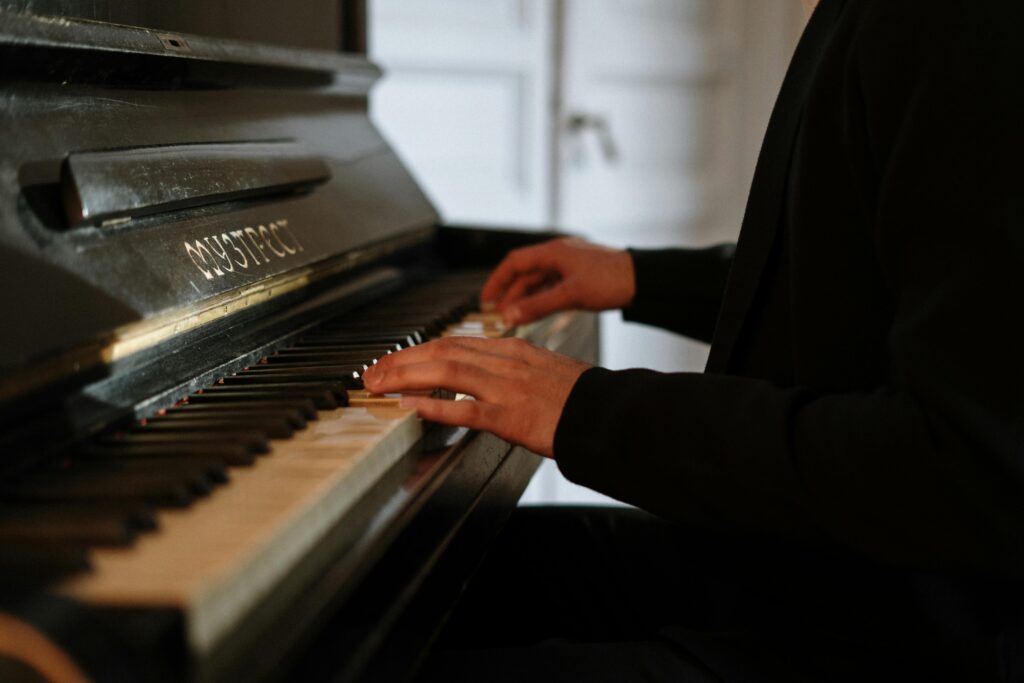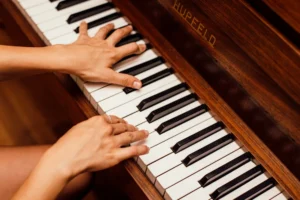The Hanon exercises have been a staple of the practice routines of virtuoso pianists for over a century. Originally developed by Charles-Louis Hanon, “The Virtuoso Pianist in Sixty Exercises” is widely celebrated for its ability to enhance finger strength, dexterity, and endurance.
No matter if you are a beginner first exploring the Hanon exercises, or a developing pianist looking to add a structured and time-tested routine to develop your technique, the Hanon exercises have something to offer every pianist. This article explores the myriad benefits of Hanon exercises, detailing how they can significantly improve a pianist’s technique and overall musicianship.
- Fall in love with the music - Learn your favorite songs, at a level suitable for you.
- Enjoy interactive piano lessons - Explore courses covering music theory, technique chords & more.
- Get real-time feedback - Skoove's feedback tells you what went well and what needs practice.

What are Hanon exercises?
Hanon exercises are a series of 60 exercises designed to develop the technical skills of piano players. Published in the 19th century, these exercises focus on finger strength, independence, and agility. The fundamental concept behind Hanon exercises is the repetition of specific patterns that train the fingers to move independently and efficiently.
Each exercise targets specific aspects of piano technique, such as finger coordination, hand strength, and finger speed. The exercises are structured to gradually increase in complexity, allowing pianists to build their skills systematically.
These patterns often involve sequences of piano notes that require the pianist to use all fingers evenly, promoting balanced muscle development in the hands. By practicing Hanon exercises regularly, pianists can achieve a level of technical proficiency that enables them to tackle more complex pieces with ease.
Benefits of Hanon exercises
The consistent practice of Hanon piano exercises offers numerous benefits that contribute to a pianist’s technical and musical development including:
- Improved finger strength and dexterity
- Enhanced finger independence
- Increased speed and agility
- Better hand coordination
- Enhanced rhythmic precision
- Improved endurance
Hanon exercises are designed to strengthen each finger, promoting evenness and control across all digits. This improvement is crucial for playing fast passages cleanly and for executing intricate pieces that require nimble fingers.
Practicing Hanon for piano improves the coordination between both hands, facilitating smoother transitions and more synchronized playing. This coordination is vital for pieces that require intricate hand movements and interactions between the left and right hands.
The exercises emphasize consistent tempo and rhythm, helping pianists internalize different time signatures and rhythmic patterns. This precision is essential for playing with other musicians and for maintaining a steady tempo during solo performances.
Regular practice of Hanon exercises builds endurance in the fingers and hands, allowing pianists to play for longer periods without fatigue. This endurance is particularly important for performing long and demanding pieces.
Hanon exercises for beginners
For beginners, Hanon exercises can provide a solid foundation for future technical development. Here are some key exercises and tips for incorporating Hanon into a beginner’s practice routine:
Exercise No. 1
This exercise focuses on finger independence and evenness. Beginners should start at a slow tempo, ensuring that each note is played evenly and with equal strength. Gradually increase the tempo as finger control improves.
Exercise No. 2
This exercise emphasizes finger strength and agility. Beginners should focus on maintaining a consistent tempo and playing each note clearly. Practice hands separately at first, then gradually combine both hands.
Exercise No. 3
This exercise targets hand coordination and finger speed. Beginners should start with a slow tempo and gradually increase the speed as their technique improves. Focus on playing each note accurately and with even pressure.
Intermediate and advanced techniques
As pianists progress, they can incorporate more advanced Hanon exercises into their practice routine to further refine their technique:
Exercise No. 20
This exercise focuses on finger agility and speed. Intermediate players should practice at a moderate tempo, gradually increasing the speed as they become more comfortable with the patterns. Pay attention to maintaining evenness and clarity in each note.
Exercise No. 31
This exercise emphasizes hand coordination and finger independence. Intermediate players should practice hands separately at first, then gradually combine both hands. Focus on playing each note with precision and control.
Exercise No. 40
This exercise targets finger strength and endurance. Advanced players should practice at a fast tempo, ensuring that each note is played evenly and with equal strength. Gradually increase the tempo as finger control improves.
Exercise No. 51
This exercise focuses on rhythmic precision and hand coordination. Advanced players should practice with a metronome to ensure consistent tempo and rhythm. Pay attention to maintaining evenness and clarity in each note.
How to practice Hanon
Effective practice of Hanon exercises requires a structured approach and attention to detail. Let’s check out some tips for practicing Hanon exercises that are directly applicable to any other piano practice you might do as well.
- Warm-up: Begin each practice session with warm-up exercises for the piano to loosen the muscles and prepare the hands for more demanding exercises. Simple scales and arpeggios are excellent warm-up exercises.
- Slow practice: Start each Hanon exercise at a slow tempo, ensuring that each note is played accurately and with even pressure. Focus on maintaining a relaxed hand position and avoiding unnecessary tension.
- Gradual tempo increase: Once comfortable with the exercise at a slow tempo, gradually increase the speed. Use a metronome to keep track of the tempo and ensure consistent progress. Avoid increasing the tempo too quickly, as this can lead to sloppy playing and bad habits.
- Hands separately: Practice each exercise with each hand separately before combining both hands. This approach helps develop finger independence and ensures that each hand is comfortable with the patterns.
- Consistent practice: Incorporate Hanon exercises into your daily practice routine, dedicating a specific portion of your practice time to technical exercises. Consistent practice is key to developing and maintaining technical proficiency.
- Listen critically: Pay attention to the sound of each note and ensure that it is played with evenness and clarity. Listen for any unevenness or inconsistencies and adjust your technique accordingly.
- Record and review: Occasionally record your practice sessions and listen to the recordings critically. Identify areas for improvement and make necessary adjustments in your practice routine.
Tips for success
Now, let’s check out some tips for success with the Hanon exercises on piano. Likewise, all of these tips are applicable to all aspects of your piano practice, not just these exercises.
| Set specific goals | Define clear and achievable goals for each practice session. For example, focus on mastering a particular exercise, improving the speed and accuracy of a drill, or perfecting the dynamics of a passage. Setting goals helps maintain motivation and provides a sense of accomplishment. |
| Stay patient and persistent | Learning the piano is a long-term commitment that requires patience and perseverance. Progress may sometimes be slow, but consistent effort and dedication will yield results over time. Embrace the process and celebrate small milestones along the way. |
| Seek feedback and guidance | Working with a piano teacher or mentor can provide valuable feedback and personalized instruction. They can help identify areas for improvement, suggest new drills and exercises, and offer guidance on musical interpretation. Don’t hesitate to ask for help and seek out opportunities for growth. |
| Enjoy the journey | Remember to enjoy the process of learning and playing the piano. Explore different genres and styles of music, experiment with improvisation, and find joy in creating beautiful sounds. Cultivate a love for the instrument and the music, and let that passion drive your practice. |
| Integrate with musical pieces | While Hanon exercises are valuable for technical development, it’s also important to apply these techniques to musical pieces. Choose repertoire that challenges your technical abilities and allows you to practice the skills developed through Hanon exercises. |
| Balance technical and musical practice | Allocate specific portions of your practice time to focus on musical interpretation and expression. Balancing technical drills with musical pieces helps you develop a well-rounded skill set and keeps practice sessions engaging. |
Hanon and musicality
While Hanon exercises are primarily technical, they can also contribute to musicality. Developing technical skills allows pianists to express musical ideas more freely and accurately in regards to dynamics, articulation, phrasing, and musical context.
You can practice Hanon exercises with varying dynamics, such as playing softly (piano) and loudly (forte) and experiment with crescendos and decrescendos to add expressiveness to the exercises. Additionally, try exploring different types of articulation, such as legato (smooth and connected) and staccato (short and detached).
In a video by Denis Zhdanov, he addresses the mixed opinions about Hanon exercises, which some piano teachers view as primitive and detrimental to musicality.
Zhdanov argues that while it’s possible to develop piano technique through other pieces, Hanon exercises can significantly benefit technical and musical aspects if taught and practiced correctly.
He emphasizes that these exercises help identify and address physical tensions in playing, develop finger independence, and improve expressivity.
Zhdanov also highlights the importance of proper instruction and tailoring exercises to individual needs, comparing the necessity of mastering fundamental skills to using appropriate tools for tasks. He concludes that Hanon exercises are particularly useful for beginners and can be a valuable part of a well-rounded practice routine.
A great part of every pianist’s journey
The structured routine of the Hanon exercises is a time-tested strategy to develop serious virtuosity on the piano. By diligently practicing the exercises and incorporating the advice given in this article, you will develop speed, dexterity, and hand independence on the piano.
As with all things piano-related, patience, persistence, and attention to detail will yield the best results. Be sure to combine these technical exercises with repertoire and other musical pursuits to truly develop a well-rounded skill set and high overall musicianship. Additionally, try incorporating Skoove into your piano experience and explore how structured and interactive learning can take your practice to the next level!
Author of this blog post:
Susana Pérez Posada

With over seven years of piano education and a deep passion for music therapy, Susana brings a unique blend of expertise to Skoove. A graduate in Music Therapy from SRH Hochschule Heidelberg and an experienced classical pianist from Universidad EAFIT, she infuses her teaching with a holistic approach that transcends traditional piano lessons. Susana’s writings for Skoove combine her rich musical knowledge with engaging storytelling, enriching the learning experience for pianists of all levels. Away from the piano, she loves exploring new places and immersing herself in a good book, believing these diverse experiences enhance her creative teaching style.
Published by Lydia Ogn from the Skoove team















